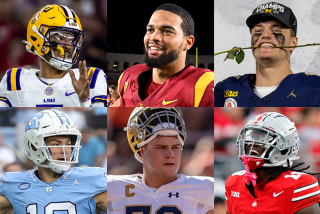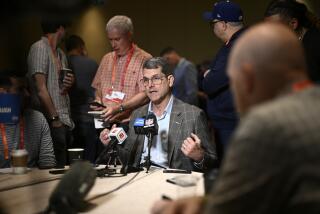PRO FOOTBALL : Getting No. 1 Pick Doesnât Ensure Success
The Tampa Bay Bucs have lost 10 or more games each season for the last decade, an NFL record. Itâs a misfortune that should bring them at least one benefit: a high draft pick.
But the release this week of Keith McCants, No. 4 overall pick in the 1990 draft, emphasizes the adage that no matter how high you pick, you still have to make the right decision. The Bucs have done that only once in a decade and that player--offensive tackle Paul Gruber--is holding out and demanding a trade.
The teamâs biggest problems is weakness at the most critical position--the owner. Hugh Culverhouse and his family have been unable to hire the right people to run the team. Ray Perkins doubling as coach and general manager from 1987 to 1990 was the biggest disaster.
In 1983, 1984 and 1992, the Bucs didnât have a first-round pick because theyâd lost them in bad trades. Two were among the worst ever:
--They lost their 1983 pick because in the 1982 draft, they meant to take defensive end Booker Reese, botched their signals, and ended up with guard Sean Farrell, not a bad pick. But they wanted Reese so badly that they dealt 1983âs No. 1 to Chicago to move up in the second round for Reese, who hasnât been heard from in years.
--In 1992, they should have had the second overall pick in the draft. But they had traded their No. 1 the previous year to Indianapolis for quarterback Chris Chandler. Chandler, who probably would start for the Bucs now, was released by coach Richard Williamson and may open the season as the starter for Phoenix.
The others?
Defensive lineman Ron Holmes (1985) had a journeymanâs career and is now out of football.
Bo Jackson, the overall No. 1 in 1986, wouldnât sign, ended up with the Raiders the next year, and, after a hip injury, is the designated hitter for the Chicago White Sox.
Vinny Testaverde, overall No. 1 in 1987, set an NFL record for interceptions in one season--because, he said, heâs color blind and couldnât distinguish Bucsâ orange from opponentsâ white. He was finally allowed to leave this year as a free agent, backs up Bernie Kosar in Cleveland, and will probably do fine there.
Gruber was taken No. 4 overall in 1988 and is one of the NFLâs fine young offensive tackles. But he may not play for the Bucs. The next three, linebacker Broderick Thomas, McCants and offensive tackle Charles McRae, have done little to justify their high picks.
So McCants is now on the open market. Chances are heâll hook up with someone. And do just fine.
AH, FREEDOM: Jay Hilgenberg is the first of a long list of victims of free agency.
The 34-year-old center, once the NFCâs hereditary Pro Bowler at that position, was cut by the Cleveland Browns, then told heâs welcome back--at about half his $1.1 million salary.
âIf he wants to go elsewhere, he will go with our blessings,â Modell said. âI would like to see him stay.â
One reason Hilgenberg was cut was that the Browns are happy with Steve Everitt, their first-round draft choice, and believe he can step right in. The Browns would like Hilgenberg to ease him along, but not for a million bucks--assistant coaches usually get in the vicinity of $120,000.
QUICK CHANGE: The Cincinnati Bengals look like they may be a double-digit loser again this year, so itâs easy to forget that only five years ago they were in the Super Bowl, losing to San Francisco on a Joe Montana-John Taylor touchdown pass with 42 seconds left.
One reason theyâve plummeted is that only five players remain from that team: wide receiver Eddie Brown, punter Lee Johnson, offensive linemen Bruce Kozerski and Joe Walter, and nose tackle Tim Krumrie. By contrast, the 49ers still have 15 players who were in that game.
âEvery time someone else goes, you think about it,â Kozerski said after kicker Jim Breech was released this week.
Since last year, the Bengals have lost, cut or traded Breech, safety David Fulcher, tackle Anthony Munoz, quarterback Boomer Esiason, receiver Tim McGee, cornerback Eric Thomas and tight end Rodney Holman, all Super Bowl starters. Fulcher, cut earlier this year, just signed with the Raiders--as a linebacker rather a strong safety.
Even the guys that are left arenât themselves.
Brown is coming back from a neck injury; Kozerski has had injury problems; Walter has had a serious knee injury; and Krumrie hasnât been the same since breaking a leg in the Super Bowl.
And with Breech and Munoz gone, 34-year-old head coach David Shula finally is older than all of his players.
RINGS ON THEIR FINGERS: The Bengals are an extreme example of how quickly things can change in football. Here are players left from Super Bowl winners from 1984 through 1990.
San Francisco (1984): three, LB Mike Walter, G Guy McIntyre, C Jesse Sapolu (on injured reserve).
Chicago (1985): eight, G Mark Bortz; K Kevin Butler; DE Richard Dent; S Shaun Gayle; LB Jim Morrissey; DT William Perry; G Tom Thayer; T Keith Van Horne.
New York Giants (1986): 11, RB Ottis Anderson; CB Mark Collins; DE Eric Dorsey; NT Erik Howard; LB Pepper Johnson; P Sean Landeta; C Bart Oates; G William Roberts; QB Phil Simms; LB Lawrence Taylor; CB Perry Williams.
Washington (1987): 12, C Jeff Bostic; S Todd Bowles; LB Monte Coleman; LB Kurt Gouveia; CB Darrell Green; T Joe Jacoby; DE Charles Mann; C Raleigh McKenzie; WR Art Monk; QB Mark Rypien (injured reserve); WR Ricky Sanders; T Ed Simmons.
San Francisco (1988): 15, Walter, McIntyre, Sapolu; T Harris Barton; K Mike Cofer; DT Kevin Fagan; CB Don Griffin; TE Brent Jones; FB Tom Rathman; WR Jerry Rice; DE Larry Roberts; LB Bill Romanowski; WR John Taylor; T Steve Wallace; QB Steve Young.
San Francisco (1989): 18, All of the above plus LB Keith DeLong, and TEs Wesley Walls and Jamie Williams.
Giants (1990): 25, Anderson; Collins; Dorsey; Howard; Johnson; Landeta; Oates; Roberts; Simms; Taylor; Williams; K Matt Bahr; TE Howard Cross; LB Steve DeOssie; T Jumbo Elliott; DE Mike Fox; S Myron Guyton; RB Rodney Hampton; S Greg Jackson; G Bob Kratch; RB-KR Dave Meggett; G Eric Moore; T Doug Reisenberg; RB Lewis Tillman; C Brian Williams.
More to Read
Go beyond the scoreboard
Get the latest on L.A.'s teams in the daily Sports Report newsletter.
You may occasionally receive promotional content from the Los Angeles Times.










